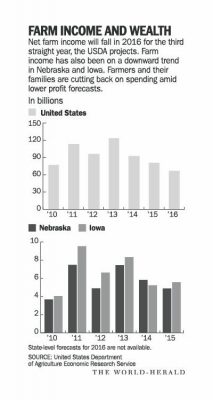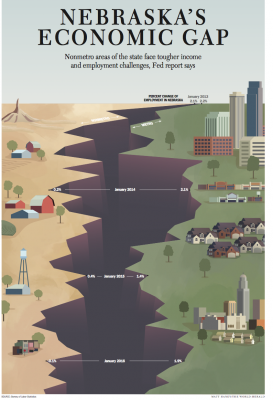Congress has quickly engaged in putting together potential aid packages for farmers that would more than double the Trump administration's $12 billion under the Farmer Bridge Assistance (FBA) Program.
“Agricultural” Economy- “Rural” Economy
In a special section of the Christmas Day edition of the Omaha World-Herald, Barbara Soderlin reported that, “The outlook may sound bleak for Nebraska’s agriculture-dependent economy as farmers wrap up the third year in a row with falling profits: The decline has economists talking about state budget cuts, rising farm loan defaults and falling land values.
“Main Street businesses that depend on farm spending say the picture might be dimmer, but they’re not yet turning out the lights.”
Missed the paper on Xmas? How the farm economy slowdown is hitting NE's Main Street businesses. With stops in Columbus, Madison, Norfolk https://t.co/vJWPGqBj6L
— Barbara Soderlin (@barbarasoderlin) December 27, 2016
Ms. Soderlin explained that, “Interviews with business owners in the heart of northeast Nebraska corn and cattle country reveal a mixed picture: Some retail shops report strong sales. Some are hustling just to keep the decline to single digits. Others say they’re managing through the downturn, shifting strategies to move where the money is, knowing that what comes down will eventually come back up.”
More specifically, the World-Herald article pointed out that, “But without big profit windfalls, farmers aren’t looking for the tax advantages that a new vehicle provides, [Chad Boettcher, dealership manage at Big Country Auto in Madison, a town of 2,400] said.”
“Boettcher said his salesmen are paying house calls to farmers, but business is down more than 20 percent compared with last December.”
“But 30 miles south in Columbus, a city nearly 10 times the size of Madison, another auto dealer painted a different picture. Sales are up at Ernst Auto Center, thanks in part to Columbus’ diverse economy, which runs on manufacturing, service and health care in addition to farming,” the article said.

Ms. Soderlin explained that, “It’s not surprising that retailers in the same line of business, but in different communities, could fare so differently, said Jerry Deichert, director of the Center for Public Affairs Research at the University of Nebraska at Omaha. ‘That makes perfect sense,’ Deichert said.
“Deichert has studied state sales tax data as a measure of economic activity, and said as farm income falls, the spending picture varies greatly from county to county depending on how rural and agriculture-dependent a place is.
The World-Herald article added that, “Some of the businesses that take a direct hit when farm prices fall said they manage by diversifying.
‘In our world, if you rely on combine sales and tractor sales to keep the lights on, you’re going to have the life expectancy of a dog that hunts alligators,’ said Art Gilfus, general manager at Platte Valley Equipment, a John Deere dealer employing about 145 people at four locations including Fremont and Wahoo.
“Platte Valley survives by also selling services, including equipment inspections and on-farm repair, helping farmers increase their productivity, Gilfus said. And the dealer is cutting back on its own capital purchases.”
The World-Herald video below provides an interesting perspective on the “ag dollar” from rural Nebraska business owners.
.@OWHnews video: The power of the "ag dollar" https://t.co/g0Z4M0aex8
— Farm Policy (@FarmPolicy) December 27, 2016
Meanwhile, in the January 2nd edition of the Omaha World-Herald, Steve Jordon reported that, “Nebraska’s economy is healthy, but its growth depends on the state’s cities because nonmetro areas haven’t kept up the pace over the past five years, according to an analysis of year-end economic trends by the Federal Reserve Bank of Kansas City.”

Mr. Jordan noted that, “For metro and nonmetro parts of the state until 2013, job growth was about the same, [Nathan Kauffman’s (the Fed’s regional economist for Nebraska)] study showed, but since then the two growth rates have diverged.
“Over the past five years annual job growth averaged 1.5 percent in Lincoln and 1.3 percent in Omaha — a respectable rate, he said — while nonmetro area job growth has been nearly flat. Low prices for grains and livestock are the key factor holding back nonmetro economies, the report said.”
‘The last couple years, there has been more divergence between metro and rural areas,’ Kauffman said. ‘It’s not unique to Nebraska.’

Recall that a recent report from the U.S. Department of Agriculture’s Economic Research Service (“Rural America at a Glance, 2016 edition“) stated that, “Rural employment has risen modestly—including an increase of about 1.3 percent between 2013 and 2015—as the national economy has recovered since employment levels bottomed out in 2010. Seasonally adjusted rural employment grew a further 0.5 percent between the end of 2015 and the second quarter of 2016. Still, the overall rural employment level remains well below its pre-recession level. Meanwhile, urban employment has risen more than twice as rapidly in recent years and was 4 percent above its 2007 level by 2015.”
As the next Farm Bill debate begins to unfold, policy observers will want to remember that although the “farm” economy and “rural” economy are intertwined and related, they are separate. And even within a “rural” state like Nebraska, economic variables between “metro” and “non-metro” areas can differ significantly.





